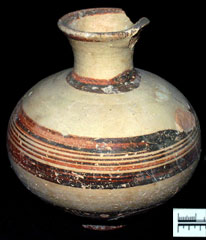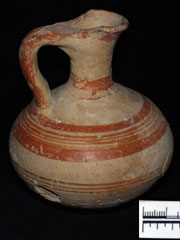| Visiting | Features | The Collections |
Services | Online Resources |
More Resources |
SiteMap |
 |
Ashmolean Museum of Art and Archaeology |
|
|
| AMULETs | |||
| Ancient
Cyprus in the Ashmolean Museum |
| Cypriot Copper: Mysteries of the Bronze Age | |||
|
Copper in Bronze Age Cyprus
|
|||
|
Objects made in places outside Cyprus are often found on Bronze Age sites on the island. These items must have been imported from other areas, and were likely exchanged for copper that was mined and turned into ingots on the island. In the Early Bronze Age, Cyprus had trading links with Anatolia [modern day Turkey] and the Levant [modern day Israel, Lebanon, Syria and Jordan]. These trading practices continued into the Middle Bronze Age. At the end of the Middle Bronze Age, there was a sudden increase in trade with the Mycenaean culture on the Greek mainland. This increase is shown in the archaeological record by the appearance of great quantities of Mycenaean pottery in layers dating to c. 1900 B.C. Trade with the Levant continued at this time, as is shown by the massive quantities of Cypriote pottery that has been found in Late Bronze Age sites in the Levant. |
 Jug of Mycenaean type, from Kormakiti, Kyrenia (AN1953.233) |
||
|
The major settlements on Bronze Age Cyprus were located near copper sources and copper smelting workshops. There was also evidence indicating trade with the Levant, North Syria, Egypt, Alalakh, Ugarit, the Palestine, Rhodes, Melos, Thera and Crete. For maps of these locations go to the Oriental Institute Map Series web pages |
|||
|
In the Early and first part of the Middle Bronze Age, Cyprus was considered by some scholars to have been unaffected by external influences in the stylistic development of their copper wares. In the Late Bronze Age, however, this changes and objects produced on Cyprus suddenly seem to reflect iconography that originated in the Aegean, Anatolia and the Levant. In about 1075 BC, there was an earthquake on Cyprus at Enkomi. It is debatable what affect this earthquake had on the rest of the island, but by the end of the Bronze Age most of the settlements on Cyprus show signs of destruction. This decline is thought to have been caused by a possible invasion by the 'Sea Peoples' (c.1200BC), a group likened by some to pirates, whose ethnic origin is hotly debated. |
 Juglet of Mycenaean type, from Kormakiti, Kyrenia (AN1953.234) |
||
| Previous
Page (When was the Bronze Age?) |
Introduction
to the Mysteries of the Bronze Age |
Next
Page (The Copper Trade) |
|
| Ancient Cyprus in the Ashmolean |
© Copyright University of Oxford, Ashmolean Museum, 2004 The Ashmolean Museum retains the copyright of all materials used here and in its Museum Web pages. Last updated: 21-oct-2004 |
|
HomePage | Visiting
| Features
| The Collections Services | Online Resources | More Resources | SiteMap | Top of Page |